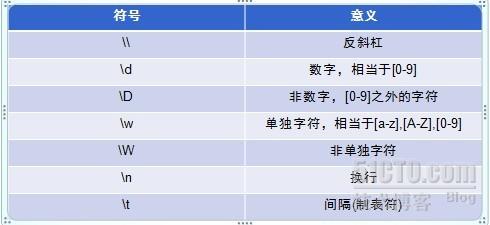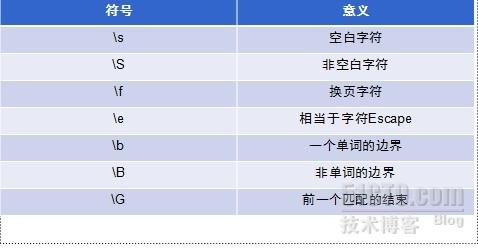正则表达示
了解正则表达示,首先要明白为什么需要正则表达示。
正则表达示是一门自然语言,并不单纯的依赖于某一种语言而存在,
在程序开发的过程当中,我们经常需要处理一些字符串,比如匹配呀,查找,替换,判断字符串的情况,如果单纯的仅仅用编码的方法一个一个来拼接,或者其他的方式来处理,我们需要浪费的太多的时间和精力,有了它,使得我们字符串处理简单而高效。
首先我们来了解一下在正则表达式中需要用的替换字符
1、 .(点号,匹配所有的字符) [](匹配指定的字符这个是单个字符的匹配) 括号”()“是[]的扩展,可以匹配多个,用|符号隔开 | (或) {}(来说明字符出现的次数) ^(表示相反的字符)
2、说明字符出现次数的符号有
*(0次或多次) +(1次或多次) ?(0次或一切) {m} 指定的M次 {n,m} 指定的M-N次
3、快捷符号:
4、敏感词汇的替换(replaceAll()等字体串中的方法就自己去体会了)
a.交集和并集的例子
public class regex3 {
/** @param args */
public static void main(String[] args) {
// TODO Auto-generated method stub
// 字符串的交集 并集
String[] str = { "A1", "B3", "E4", "F3", "G5", "M9" };
String reg = "[A-F&&E-M][0-9]";// 交集
for (String string : str) {
if (string.matches(reg)) {
System.out.println(string);
}
}
System.out.println("^^^^^^^^^^^^^^^^^^");
String reg1 = "[A-B[G-M]][0-9]";// 并集
for (String string : str) {
if (string.matches(reg1)) {
System.out.println(string);
}
}
String str2 = "*";
String reg2="\\D";
if(str2.matches(reg2)){
System.out.println(str2);
}
}
}
b.通过Pattern来匹配的邮箱例子:
public class Regex2 {
/** @param args */
public static void main(String[] args) {
// TODO Auto-generated method stub
String mystr = "The theatre is the greatest from of live"+
"entertainment according to thespians.";
String reg1 = "the[a-z]";
//截取包含正则表达式的字符串
Pattern pattern = Pattern.compile(reg1);
//首先把正则表达示编译成一个pattern对象
Matcher matcher = pattern.matcher(mystr);
//根据样式对象pattern针对这字符串生成一个扫描器matcher
while(matcher.find()){
System.out.println(matcher.group());//用group用来得到匹配的字符
}
String str1="[email protected]";
parse(str1);
}
private static void parse(String line) {
Pattern p = Pattern.compile("[\\w[.-]]+@[\\w[.-]]+\\.[\\w]+");
Matcher m = p.matcher(line);
while(m.find()) {
System.out.println(m.group());
}
}
}
c.敏感词汇的替换
public class Regex5 {
/** @param args */
public static void main(String[] args) {
// TODO Auto-generated method stub
File file = new File("a.txt");
try {
BufferedReader fin = new BufferedReader(new FileReader(file));
String str = "";
String regex = "国民党";
while ((str = fin.readLine()) != null) {
Pattern p = Pattern.compile(regex);
Matcher m = p.matcher(str);
StringBuffer sb = new StringBuffer();
while (m.find()) {
m.appendReplacement(sb, "vickyi");//"vickyi"用来替换"国民党" 把找到的替换放到SB中
}
m.appendTail(sb);
System.out.println(sb.toString());
}
} catch (Exception e) {
// TODO Auto-generated catch block
e.printStackTrace();
}
}
}
正则表达示是一个很神奇的东西,在有些地方用得好的话,可以省去好多的脑力活动。深入的研究一下正则表达示很有必要。


